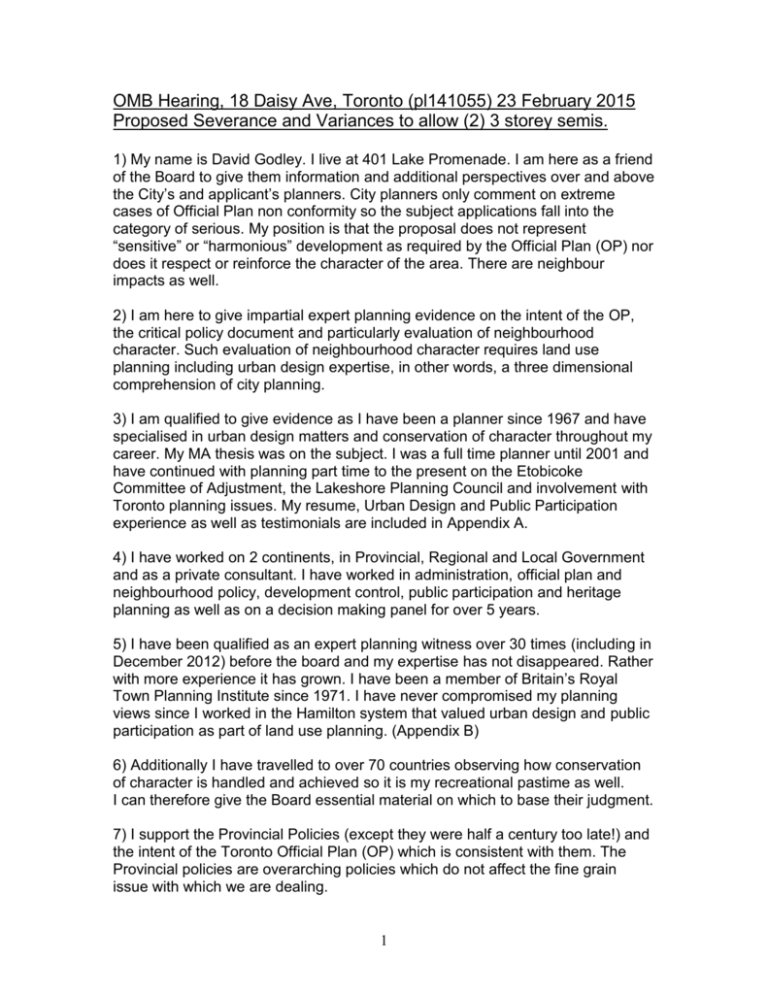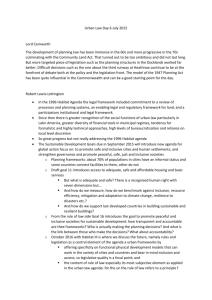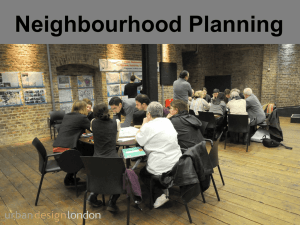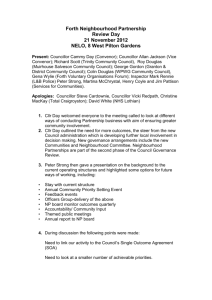General Intent and Purpose of Zoning Bylaw
advertisement

OMB Hearing, 18 Daisy Ave, Toronto (pl141055) 23 February 2015 Proposed Severance and Variances to allow (2) 3 storey semis. 1) My name is David Godley. I live at 401 Lake Promenade. I am here as a friend of the Board to give them information and additional perspectives over and above the City’s and applicant’s planners. City planners only comment on extreme cases of Official Plan non conformity so the subject applications fall into the category of serious. My position is that the proposal does not represent “sensitive” or “harmonious” development as required by the Official Plan (OP) nor does it respect or reinforce the character of the area. There are neighbour impacts as well. 2) I am here to give impartial expert planning evidence on the intent of the OP, the critical policy document and particularly evaluation of neighbourhood character. Such evaluation of neighbourhood character requires land use planning including urban design expertise, in other words, a three dimensional comprehension of city planning. 3) I am qualified to give evidence as I have been a planner since 1967 and have specialised in urban design matters and conservation of character throughout my career. My MA thesis was on the subject. I was a full time planner until 2001 and have continued with planning part time to the present on the Etobicoke Committee of Adjustment, the Lakeshore Planning Council and involvement with Toronto planning issues. My resume, Urban Design and Public Participation experience as well as testimonials are included in Appendix A. 4) I have worked on 2 continents, in Provincial, Regional and Local Government and as a private consultant. I have worked in administration, official plan and neighbourhood policy, development control, public participation and heritage planning as well as on a decision making panel for over 5 years. 5) I have been qualified as an expert planning witness over 30 times (including in December 2012) before the board and my expertise has not disappeared. Rather with more experience it has grown. I have been a member of Britain’s Royal Town Planning Institute since 1971. I have never compromised my planning views since I worked in the Hamilton system that valued urban design and public participation as part of land use planning. (Appendix B) 6) Additionally I have travelled to over 70 countries observing how conservation of character is handled and achieved so it is my recreational pastime as well. I can therefore give the Board essential material on which to base their judgment. 7) I support the Provincial Policies (except they were half a century too late!) and the intent of the Toronto Official Plan (OP) which is consistent with them. The Provincial policies are overarching policies which do not affect the fine grain issue with which we are dealing. 1 8) I support the redevelopment of Avenues such as Lake Shore Blvd and proposed more density at the transportation node at Long Branch Loop. I encouraged one developer to provide a small square modeled on the one in Port Credit and another developer to build a taller tower. Both developers responded positively. The City of Toronto supports sunny spaces such as the square on the north side of Lake Shore Blvd in the Long Branch North Neighbourhood, according to their OP Review material. 9) I support the one and only cornerstone strategy of the Official Plan which is to safeguard the character of neighbourhoods and direct development to Avenues, Employment Districts, Centres and the Downtown. The OP introduction to “Shaping the City” says this strategy is the first layer of sound planning. Essentially the OP says that conservation of neighbourhood character trumps density in “Neighbourhoods” designations, such as this. 10) Overall Toronto probably has the best neighbourhoods in North America. It is known as the City of Neighbourhoods with good reason. They are a major aspect of quality of life and a critical economic asset. This is recognised in the OP. To allow neighbourhoods to lose their character is detrimental to the City. This has already started to happen in Long Branch and other neighbourhoods. Alderwood, to the north, has had a complete change of character in parts and those residents in smaller houses feel hemmed in and threatened. Citizens have lacked the know-how to defend their area. Even with organisational skills it is an uphill battle for residents to counter the well oiled machine of the development industry. Part of my role is to even out the balance discrepancy. 11) There are abundant lands to accommodate forecast growth and the time frame of the Official Plan can take this in Avenues alone. The developing waterfront area of the downtown is almost as large as the current downtown and operates as a safety valve for population decades in to the future. 12) I have supported the major projects in Long Branch along Lake Shore Blvd (an Avenue) and this has so far provided about 1000 housing units. I supported a similar severance but for singles a block and half from my house because it was in a row with a majority of 25 feet wide lots and the prevailing use was detached housing. 13) I have remained neutral on some severances but have not supported certain other lot splits because they are clearly not in accordance with the intent of the Official Plan and they do not respect or reinforce the character of the neighbourhood. Impacted residents also opposed. These applications are ones that clearly offend OP policies. The micro level is the key level in which to assess single severances and variances and the macro or neighbourhood level gives a framework. The intent is explained in the OP under Development Criteria (beginning of Section 4). Theother lot splits were radical changes and an 2 introduction of an intrusive house form with no relationship to the distinctive character of the neighbourhood. The massing and spacing of these forms of housing is in diametric contrast to the prevailing character of modest smaller houses. They reduced the quality of life in the neighbourhood both visually and physically. 14) The triangular neighbourhood of North Long Branch is well defined by the main line railway to the north, Lake Shore Blvd to the south and Kipling Avenue, an arterial road, to the east. This is the area to which residents relate. 15) The neighbourhood is not static; in fact it is a hive of building activity. Development applications abound and are increasing. Stability is affected when any lot 45 feet wide or more lot is at risk of being redeveloped in crowded modern subdivision style especially if it has severe impacts as the 18 Daisy application. 16) I have been consistent in supporting the Official Plan. If a proposal directly affected me I would not give professional evidence. 17) I have given the Board an acknowledgement that I will provide evidence that is fair, objective and non partisan, provide opinion evidence that is related to only to the matters that are within my expertise and will give the Board any additional assistance it requires. (Appendix C) 18) As a comparative analysis, this approach is in contrast to the development planner’s approach. Splitting lots of 45 feet into semi detached lots is virtually unprecedented in North Long Branch and the wider Lakeshore area. With such a large mass at 1 times lot coverage and 3 storey the proposal is in stark contrast to anything else in this basically single family area. Building structures alien to the traditional neighbourhood character, indicates the applicant has little grasp of urban design and their planners are not fully qualified to evaluate neighbourhood character. 19) Their proposals are generated from the inside out. Saying there are other similar developments in the neighbourhood is irrelevant particularly as they are not prevailing. To reflect and reinforce character the proposals need to be developed from the outside as well. Only this way can the character of the neighbourhood be absorbed into the proposed development. Instead we have some developments which are different in nature and more akin to a new development in places like Mississauga. This includes all the 3 storey detached house lot splits as well as semis. The City has been neglectful in allowing neighbourhood character to deteriorate. 20) The proposals usually severely impact their neighbours. The street rhythm is disrupted and residents are concerned about more similar type of development with all the negative repercussions. Inappropriate approvals, (that do not conform 3 to the OP) have led to more applications. In fact if the planning policies of the OP were followed we would not be here today because the hope of severance would have disappeared for such properties as 18 Daisy. 20) The approach of saying there are other properties in the area like the one proposed is tantamount to saying there are no policies. The approach is illogical and contrary to good planning. 21) Any person passing by would be able to see the proposed development sticks out like a sore thumb in terms of massing and spacing because the lots are so narrow and with the increase in density from 35% to 100% (in the subject case) about two and a half times larger than currently permitted on the lot. “Nearby massing” referenced in the OP (4.1.5 c) is a critical element of compatibility and relates strongly to lot frontage, number of storeys and density. I comment later using specific figures. 22) Although residents, as experts on the neighbourhood, often plead to have their concerns taken into account there is no evidence they did in a number of approvals. Decisions were sometimes based on “expert opinion” from development planners which has resulted in a hotch potch of development with narrow lots for both singles and semis dotting the low density neighbourhood. 23) Once applications are made they have to conform to the Official Plan in all aspects such as impacts on neighbours and of course neighbourhood character. Although there are 3 applications we are considering one development proposal. 24) OP policies (Section 3.1.3) require that new development be “massed and its exterior façade will be designed to fit harmoniously into its existing and planned context”. It has policies on protecting light, sunlight and privacy. In addition the intent of the zoning bylaw would be to protect views and overpowering walls. OP Section 3.1.1d requires enhanced public realm and encourages use of skilled professionals for design which does not appear to be the case here. Managing groundwater infiltration is important (Section 3.4.2) as wet basement problems are common in this neighbourhood with underground streams. A now covered stream runs through the 18 Daisy property and would be impacted by greater lot coverage. 25) An important aspect of a planning decision is support or opposition from the local community. Within the City planning framework citizens should have some power to shape their neighbourhood. This is simply good planning as opposed to a top down, authoritarian, technocratic, elitist approach. Planning is an art and science. If the local community support the application, along with the Committee of Adjustment and agencies, all is well and good. If they do not support it, weight needs to be given to their thoughts and feelings about their area to allow some control over the future of their neighbourhood in which they live. 4 26) Residents have made probably the largest investment in their life in a house and it is imperative to have their own property rights protected. Thus there is a fair balance between local and citywide interests. An incorrect decision made in a day will have implications for 100 years at least. 27) The planning tenet of “localism” has been invoked nationally in English planning and is implemented by Community Boards in New York. The stakeholders have a greater control in the neighbourhood than the developer whose job is to bring a plan to fruition. However the development industry’s role is essential in bringing about implementation within the legal and planning framework of the overall community. 28) The City of Hamilton (Appendix B) follows this approach through Neighbourhood Plans. City of Hamilton planning philosophy is that decisions should be made on issues as close to the impact level as possible. Mississauga is using citizen led planning with success in Lakeview, to the west of Long Branch. The balance between City wide interests and those locally impacted is central to good planning. This is public participation or civic engagement which all professional planners support. This is endorsed by the Planning Act and Official Plan through notification and public meeting requirements. 29) The applicant is asked on forms why the proposals cannot meet the current criteria. There is no reason to change the current planning requirement as the lot is intended for detached house. The real answer is to make more money. It would be simpler to build a single house like the builder at 27 33rd Street was persuaded to do. This gives a good example of infill with architectural sensitivity to the surroundings. 30) I have demonstrated that I am not anti development and have been consistent all my career with neighbourhood character evaluation. 31) In contrast, the development planner has a direct and indirect pecuniary interest. The applicant pays the planner and if successful will get more commissions. Membership of professional associations is not necessarily the defining issue because the defence that “it is my opinion” cannot be refuted. The unaccountable development planner therefore may look for a way to try to bypass official policy by emphasising certain aspects and skimming over other aspects. The blind acceptance of such evidence by decision makers has directed “the ship of planning” well off course. 32) Professional membership of a planning association does not automatically imply expert status. Planners have specialisms just like doctors. A dermatologist would not give an expert advice on oncology. It is training and experience that are the determinants. The superficial determination that a member of CIP is automatically an expert planner is erroneous and has resulted in approval decisions misconstruing the Official Plan policies and good planning. 5 33) I was privileged to be on the Committee of Adjustment when we were briefed by City Planners on the policies and intent of the OP and had to apply the OP policies to many applications. I am also aware of the process in finalising the Official Plan where many detailed negotiations took place to improve the wording, particularly on character criteria. 34) The Etobicoke Official Plan used the words “neighbourhood fit” and “compatibility”. The Official Plan sought to strengthen the wording and did so after careful consultation and consideration. Nobody anticipated the bizarre angle of the developer’s planner – if there is similar development somewhere in the neighbourhood it conforms to the Official Plan. The current Official Plan is being undermined by inappropriate approvals. Every inappropriate approval has the double impact of incompatible housing and encouraging more. 35) The Etobicoke Plan was strong enough to have 32 33rd Street severance turned down. The City used my basic way of evaluating neighbourhood character. This is to take a smaller area that can be seen clearly from the street as a group rather than large meaningless study area. Planners involved in the current review of the OP are likely to be including my basic process for evaluation for clarification as they have had many qualified people telling them to do this to block the loophole created by imaginative development planners. 36) The way the development planners do this is to draw an arbitrary study area containing 100s of houses. Then they say that if there is a similar property in the study area it conforms to the Official Plan. This demonstrates a basic misunderstanding of neighbourhood character and the OP. It is irrational because based on this assumption, (2) 3 storey semi detached houses could be built on any 45 feet plus lot, if this is approved. 37) Section 4.1.5 of the OP states “Development in established Neighbourhoods will respect and reinforce the existing physical character of the neighbourhood.” This does not mean part of a neighbourhood, a sample area or a study area. In the OP Review, to ensure this means a realistic neighbourhood, discussion has been around adding “geographic” to ensure that it is not just part of the neighbourhood such as a study area. 38) North Long Branch is the relevant neighbourhood as it has common schools, recreation facilities and commercial strip along Lake Shore Boulevard. It is one of the most physically defined areas in the City. 39) Size and configuration of lots is criterion b in Section 4.1.5 of the OP. An estimated 650 plus lots contain detached houses whereas there are about 30 semi detached lots and 36 plexes from an on site count. The older plexes are 2 stories and fit into the neighbourhood much better than any 3 storey development. Consequently the prevailing character (the key OP words) is 6 overwhelmingly detached houses. All recent semi detached housing on lots that do not meet semi detached standards have been approved by people who are only superficially aware of Official Plan policies or who substitute intuition for facts. The OMB has to have regard for the decision of the Committee of Adjustment which is refusal. The two members of the Committee who voted for the application are severely out of touch with reality. 40) Criterion c is “heights, massing and scale and dwelling type of nearby residential properties”. My underlining. This involves mass, space, density and lot frontage. 41) Buildings 2 to 24 Daisy are the critical determinant of respect and reinforcement of the neighbourhood character. This has been reinforced by debate with the OP Review team. The two either side are also critical. The buildings across the road are mainly detached but there are two pairs of 2 storey semis ,one older, one newer and should have no influence because they are in a minority and are a less important factor than the subject row. It is the key row one sees when passing along the street that is the main consideration. 42) The detailed neighbourhood character is formed from an amalgam of streets and sections of streets, particularly in North Long Branch where there are contrasting characters. A similar development around the corner or across the street does not mean it is appropriate because context is different. Context is pivotal. The development must reflect the rhythm of the street rather some outlier development. 43) OMB decisions on 241 and 251 Golfdale Road, Toronto (pl 081436,121038) and 200 Keele Street, Toronto (pl 090507) confirm this relatively tight area of properties is appropriate. 44) Approval of this application will mean all these lots of 45 feet and over are ripe for splitting into semi detached lots, a domino effect. 2 27th Street was authorised for splitting and now there is an application for the next door property to be split. 45) The intent of the zoning bylaw is to have low density development with plenty of space around buildings and room for trees and vegetation. It also reduces the potential for overshadowing, overseeing and overbearing development. This is the reason why people move to North Long Branch. The approximately 180% increase of density does not comply with the intent of the zoning bylaws. Even from a semi detached form of housing the increase is 60%.The number of variances (10) attest to the overbuilt form. All the recent inappropriate approvals have been based on the fallacy that minor has the same meaning as major. The Committee of Adjustment is now seen as the Committee of radical change. None of the many new 3 storey detached houses on narrow lots bear any relationship to scale, harmony, massing, compatibility, architectural facades etc of their 7 surroundings and are all planning mistakes. The Committee of Adjustment nearly always approve severances where there are no objectors despite it being difficult for people to take a day off work or perhaps 2 if a matter is deferred. Similarly at the OMB it is an arduous process for residents to break from their routines and be subject often to intimidation at the Board. The most serious case so far was 2 27th Street where the Committee of Adjustment approved an application because residents did not attend a second time and the OMB made fundamental errors at the hearing including intimidating witnesses. The “ship of planning” needs steering back on course. 46) Variances need to be minor both in size and impact. See De Gaspris Divisional Court and 364 Lake Promenade (pl 110395-7) denial of severance. This again is something that has changed over time from a 10% guideline which reflects “small” the dictionary definition. No change has been made to the Planning Act. 47) Zoning is the planned development. The Official Plan requires both existing and planned development to be reflected and reinforced. 22.5 feet lot frontages do not reflect the zoning requirement of 35 feet frontage for semi detached or 40 feet for detached development. 48) Nearby properties have the following statistics and are compared to the proposal. Planned density is for detached house lots. Density is derived from MPAC data. 2 Daisy Frontage (feet) 42 Density 0.35 Planned Density 0.35 Storeys 2 0.25 0.35 1.5 10 Daisy 45 18 Daisy (subject site, see below) 20 Daisy 35 0.42 0.35 2 22 Daisy 35 0.16 0.35 1.5 24 Daisy 40 0.45 0.35 2 1.8 Average 39 0.33 0.35 18 Daisy (proposal x2) 45 22.5 0.15 1.00 0.35 1.00 8 1 3 Average shows the tenor of the appearance of the block. Any development proposed should not exceed the extremes of these figures. For example 3 storeys is introducing a new element entirely. Again it is important to note that an application for severance is submitted all facets of the Official Plan must be met. 49) The proposal exceeds planned density of the urban design character framework by nearly 200%. It exceeds existing density of the row by over 200%; lot frontage is lower by 60%. None of these figures can be considered minor or have minor impact. There is a glaring disparity between the proposal and to both planned and existing development. No consideration of either OP or zoning appears to have been given in this application. Impacts on abutting properties due to mass are major and particularly damaging to 20 Daisy. . 50) The bulk and scale of the building are an opposite form to the extant wider lower buildings. Privacy will be impacted by the multiple windows on the side of the proposed design. This will be particularly so for 20 Daisy where 6 windows face the proposal including the kitchen window which is the main workplace. The high and long wall (increased by the added density) will make 20 Daisy a darker house. An architect for a detached home on this lot, the desirable use, would be able to minimise impacts. The massing will affect owners to the rear as well. 51) The overwhelming prevailing character of the neighbourhood is detached houses. The same is true for the block. Semis are not permitted by the OP. 52) Section 4.1.5 of the Official Plan requires “No changes will be made through the zoning bylaw, minor variance or consent that are out of keeping with the character of the neighbourhood”. The proposal is blatantly out of keeping. Any change must conform to the rest of the policies including impacts on neighbours (Section 3.1.2) and water percolation (Section 3.4.1) 53) From the criteria in the Planning Act the severance fails the following tests a) This is a local matter and not of Provincial interest. There has been no Provincial input. Since the OP is consistent with the Provincial Policy Statements (PPS) and addresses density issues, the PPS is not relevant. c) The City of Toronto OP policies are basically ignored and substantially transgressed. d) It is unsuitable for the proposal but suitable for a detached house. f) The dimensions of the lots are too narrow. The 10 variances underline this. 54) The proposal is a major departure from both relevant zoning ordinances. The proposal does not conform to the intent of the Official Plan. The proposal is unsuitable and with creep/domino effect will lead to more unsuitable development. 55) The application fails all germane tests and criteria. 9 DAVID GODLEY, MA, MRTPI (Rt) Planning Consultant 401 Lake Promenade, Toronto, Ontario, M8W 1C3, Canada Tel 416 255.0492 APPENDIX A PLANNING EXPERIENCE Planning evidence to the OMB on 30+ occasions. 2001-06 Toronto City Committee of Adjustment Member 1997-01 Planner Town of Dundas & New City of Hamilton 1995-97 Planner, Local Planning, City of Hamilton 1991-95 Manager, Plans Admin, Hamilton-Wentworth 1977-91 Manager, Local Planning Policy, City of Hamilton 1974-77 Planner, Plans Admin, Ontario Housing Ministry 1970-74 Senior Planner, Urban Design, Rotherham, UK 1967-70 Planner, Policy and Control, Doncaster, UK EDUCATION 1970-72 MA, Urban Planning, Sheffield University, UK 1963-66 Surveyors Diploma, Reading University, UK COMMUNITY SERVICE 2011-2015 Planning Aid Consultant 1991-2011 Lakeshore Planning Council 1985-1991 Hamilton Social Planning Council Board 1979-1985 Hamilton Community Information Services Board 1969-1971 Doncaster Civic Trust, UK, Planning Committee PROFESSIONAL MEMBERSHIP Royal Town Planning Institute, UK (Designation is “Retired”) 10 DAVID GODLEY, MA, MRTPI Planning Consultant 401 Lake Promenade, Toronto, Ontario, M8W 1C3, Canada Tel 416 255.0492 Urban design and Neighbourhood Character - Selected Experience. Recent Evidence Prepared for OMB on Neighbourhood character using Urban Design Framework as Basis (2015) 20 James Street (2014) 82 27th Street (2014) 6 Shamrock Avenue (2013) 2 27th Street, Toronto (2012) 168 Lake Promenade, Toronto (2010) 51 Lakeshore Drive, Toronto Town of Dundas Park Street, Dundas (Severances, Variances and Site Plans) The new houses are so well integrated you cannot tell them from century homes. City of Hamilton Planning Advisor to LACAC. Project manager which resulted in the first Heritage district designation in Hamilton and sixth in Ontario. Borough of Rotherham 2 years as an Urban Design planner. University of Sheffield Urban Design and Architectural Courses Thesis on Urban Conservation, maintaining community character. Borough of Doncaster I year Development Control in which aesthetics were key. Planner for heritage files. Civic Trust, Doncaster 2 years on the Planning Committee reviewing planning applications. 11 DAVID GODLEY, MA, MRTPI Planning Consultant 401 Lake Promenade, Toronto, Ontario, M8W 1C3, Canada Tel 416 255.0492 Public Participation Selected Experience Recent 3600 Lake Shore Blvd West. As part of submission and meeting developer and architect the design of 600 housing units was radically changed to create a small urban square. Lakeshore Planning Council (1991 – 2011). Focused on advising the community on public participation processes. Part of Neighbourhood Plan prepared by Council for designating Lakeshore Hospital Grounds as institutional and public open space rather than residential. Stitt, Feld, Handy Group. 2 week Mediation Course (2001). Town of Dundas Saved a major heritage building by division of lots involving public meetings with community. City of Hamilton. 15 years of neighbourhood planning, about 1 a year and major studies such as Central Area , Seniors Community Centre, Social Housing, Heritage Districts, using Stakeholder Advisory Committees. Ministry of Municipal Affairs and Housing. Planner for the first Regional Plan in Ontario which had comprehensive public participation. Borough of Rotherham. Head of a team preparing General Improvement Area schemes to improve neighbourhoods to the satisfaction of the community. University of Sheffield. Non elective course on Public Participation. The Skeffington Report revolutionized public participation. 12 DAVID GODLEY MA MRTPI Professional Planner 401 Lake Promenade, Toronto, Ontario, M8W 1C3. Tel 416 255.0492 TESTIMONIALS ALF CHAPMAN, FORMER ONTARIO MUNICIPAL BOARD MEMBER “The Board heard from Mr. Godley who is a well qualified planner and struck the Board as being a fair and good man” DONALD GRANGER, FORMER MOHAWK COLLEGE PROFESSOR FORMER ONTARIO MUNICIPAL BOARD MEMBER “I have found David to be eager to involve and encourage both students and the general public in their practical learning” TONY DI SILVESTRO, BUILDER AND DEVELOPER, HAMILTON “Together we have dealt with many planning issues and negotiated solutions that have always received support of the elected officials.” WES ROSE, SCHEIDEL CONSTRUCTION, CAMBRIDGE “Working with yourself and your fellow staff was a positive process. Also, I feel that you balanced the requirements of the Town and the needs of the customer very well.” VICTOR ABRAHAM, CITY OF HAMILTON PLANNING DIRECTOR “David was dependable and able to carry through assigned planning tasks on target.” CY McKENNA, FLAMBOROUGH RESIDENT “without his assistance and guidance to myself and others in the area, our task would have been much more difficult.” REVEREND BOB NICHOLLS, UNITED CHURCH MINISTER “is a person of integrity who cares for his family, his work and his community and takes seriously his responsibilities in each area. DIANA SANTO, DIRECTOR, MINISTRY OF MUNICIPAL AFFAIRS AND HOUSING. FORMER MUNICIPAL BOARD MEMBER. “Would definitely rehire” 13









